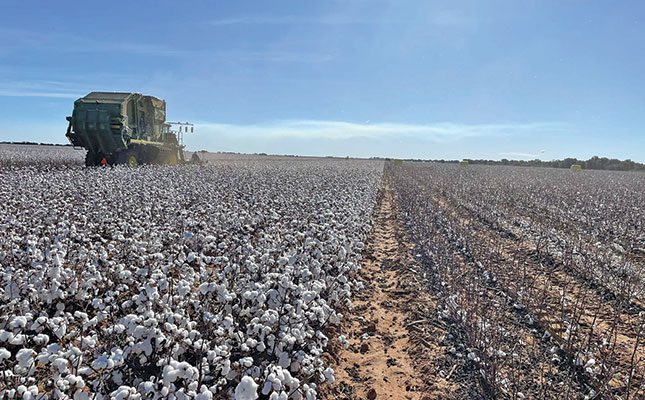
Cotton, the ‘white gold’ of dryland crop production in SA
The producer price for dryland seed cotton in areas of the North West, such as Schweizer-Reneke, stood, at the time of going to print, at R12 000/t, compared with the maize producer price, which hovered at R3 200/t and soya bean at R8 000/t at a yield obtained under dryland conditions of 3,40t/ha, 6t/ha and 3t/ha respectively.
According to Louis Olivier, CEO of Vaalharts Cotton, the production costs for cotton in the 2022/23 season amounted to R22 620/ ha, compared with R16 000/ha for maize and R10 000/ha for soya bean. In the case of cotton, it means a profit of R18 179/ha, compared with R3 200/ ha for maize and R14 000/ha for soya bean.
Dollar price
Jozeph du Plessis from Schweizer-Reneke is one of the pioneering cotton producers in North West. According to him, one of the top benefits of the South African cotton price is that it is coupled to the international NY futures dollar price.
“Because of the widespread political and infrastructural deterioration in South Africa, it is imperative that the local commercial crop farming sector considers alternative crops where the price can be based on a dollar-based futures December price of the coming season, or a spot price that can be negotiated with brokers or agents,” he said at a recent cotton information day.
He pointed out that the demand for the crop outweighs the supply by far, which adds markedly to the advantage of cotton production compared to other rotational crops such as maize and soya bean. Cotton prices do not fluctuate between export and import parity like maize and soya bean, which are produced in surplus, and cotton is thus able to be exported profitably.
Drought and heat
An added bonus is that cotton is able to withstand the extreme drought and heat conditions to which North West is regularly exposed much better than the traditional crops produced in areas such as Delareyville, Schweizer-Reneke and Stella.
A cotton plant has an outstanding ability to extract moisture from the soil with its strong and penetrating taproot system. The taproot is often longer than 1m, and in Schweizer-Reneke, it can reach the deep moisture in the soil with ease, making the crop especially suitable for dryland areas with deep soils.
The crop is well adapted to the warmer northern and western parts of South Africa. In North West, cotton needs to be planted in the last two weeks of October and no later than the first week of November. Summer temperatures in excess of 25°C are ideal for cotton production, but preferably not warmer than 38°C.
Full sunshine for 70% to 90% of daylight hours is ideal, with little or no cloudy weather. However, the crop does not do well in soil temperatures lower than 18°C. The plant stops growing at minimum temperatures below 15,5°C.
Crop rotation
According to Du Plessis, cotton is a priority crop and should be planted in rotation with maize and soya bean. Maize planted in lands that were previously planted with cotton shows yields that are markedly better than when maize is planted in monoculture or even in rotation with soya beans. He says he has harvested as much as 1t to 1,5t more on fields where maize was planted in rotation with cotton.
Farmer’s Weekly incidentally reported as early as 2021 on a study that found that cotton could be a profitable rotation crop for sugar cane producers and that it holds benefits for soil health as well. This emerged from a study conducted as part of the Sugar Value Chain Master Plan.
Small-scale cotton production also requires relatively low start-up capital if land preparation, fencing and input costs can be funded by government, making it an ideal rotational crop for small-scale growers. Where cotton is farmed in a small-scale setup, it creates 1,35 jobs/ha and provides short-term job opportunities for the manual handpicking of cotton during the harvest season.
High input costs
This is in comparison with the high capital outlay required for expensive mechanisation associated with commercial operations. However, larger production areas of around 50ha are required for smallholders to farm profitably.
Around 20ha in a smallholder set-up is about the maximum that can be handpicked during a season. Planning to plant on larger areas should include careful planning for access to harvesting equipment, perhaps two or four row pickers.
“On the other hand,” says Du Plessis, “highly expensive mechanisation is inevitable for commercial producers as cotton production is very intensive.”
He advises prospective commercial cotton producers to pool their resources and purchase the necessary machinery and equipment co-operatively. A second-hand cotton picker in good condition, imported from the US, goes for as much as R10 million. Du Plessis nonetheless says that the return on investment is high and mechanisation costs should consequently not be seen as a stumbling block.
There are two types of harvesting machines in use today, namely spindle-type cotton pickers and stripper-type cotton pickers. The spindle picker physically pulls the cotton from the boll by means of spindles in the picker heads. The stripper, as the name implies, slices the boll and leaves away from the plant, and strips all plant material from the plant. The seed cotton usually has more leaves and trash than in the case of spindle picking.
Du Plessis and his fellow cotton producers favour stripper-type pickers for dryland harvesting, while for higher yields achieved under dryland conditions, spindle-type pickers are also used.
“Cotton is the ideal option, in my opinion, for diversification and spreading the risk of drought effects on crop performance in our province. Not only is cotton stover an ideal food source to support cattle on, but cotton is not easily stolen and carted away. Crop theft and theft of agricultural chemicals have become nearly endemic in North West, a reality most crop producers have to deal with virtually on a daily basis,” he explains.
The volatile weather conditions are another of the challenges that producers have to deal with. Because cotton needs to be planted early in summer, access to shorter-growing cultivars is of the essence. Cultivars that have a shorter growing period (less than 160 days) would make planting through November possible, and still enable farmers to have a good crop.
However, the only cultivars available in the country at the moment take in excess of 160 days to mature, which limits the planting to the latter half of October and the first week of November.
Plant depth is another factor that needs to be managed carefully. Cotton plants often experience problems with germination and vigour, and should therefore not be planted more than about 3cm (three fingers) deep.
Cotton seed prefers an average minimum soil temperature of 18°C for 10 days before planting for optimum germination. The growth period between cultivars and regions varies between 165 and 180 days.
Versatile and renewable
Dr Annette Bennett, Cotton South Africa CEO, says cotton is the only fibre crop that is edible and also used in textiles. “Cotton is sustainable, renewable, biodegradable and carbon-neutral. It prefers dry, hot, desert-like production conditions but is susceptible to frost. But by the time frost comes, the crop must have reached maturity, which emphasises the importance of the planting date.”
Bt cultivars
All cotton cultivars planted in South Africa express bollworm resistance due to two Bt-genes in stack gene formation (Bollgard 2), combined with herbicide tolerance expressed by the Roundup Ready Flex trait, which provides glyphosate resistance.
Seed treatments are applied to seed to provide protection against early-season sucking pests like thrips, aphids and leafhoppers, and against some fungal diseases. The cultivars that are planted include DP 1541 BG2RF, DP 1240 BG2RF, Candia BG2RF, PM 3225 BG2RF (Paymaster) and Delta 18 RF. PM 3225 BG2RF is planted by smallholders and is a hairy cultivar, while all the others have smooth leaf surfaces.
The refuge area must be planted with Delta 18RF, which is a non-Bt cultivar. There is a licence agreement that producers must sign, which also explains the options the producer has to plant the refuge areas.
Marketing pools
Bennett says most South African cotton is sold through marketing pools. This is more popular with farmers because it offers substantial economies of scale in marketing.
According to this arrangement, each ginner pools the producer’s cotton into larger lots and manages the marketing of the pool’s cotton. The ginner uses the size of the marketing pool to negotiate suitable premiums for cotton.
Individual producers have the option to market their cotton themselves, with or without the assistance of an agent or broker, following contract ginning or so-called toll ginning. Farmers are normally offered a below-market, upfront cash payment based on the volume of seed cotton placed in the pool.
Then, as the cotton is sold to merchants or textile mills, the net proceeds of the sales are distributed back to the farmers, after deducting some costs like ginning fees and statutory levy.
In all cases, prices for individual lots of cotton will reflect discounts or premiums for quality different from the base quality quoted in the international markets.
The main advantage of the marketing pool is that it offers a form of price risk management since each producer will receive the average price achieved by the entire pool, adjusted for the quality delivered, and the farmer does not have to worry that his or her particular cotton was sold when the market price was lowest.
International reference price
The international reference price for cotton at the time of writing the article stood at a weekly average price, based on the December 2023 NY Futures Basis Lint price of R34/kg (week ending 7 July 2023).
It is important to note that this is only an average reference price for the particular week. The final price will be determined by the applicable marketing model and the actual quality of the lint, and will depend on what deductions are made for relevant costs, e.g. transport, ginning, grading, levies, export and storage.
“All this said and done, cotton should be your preferred crop for planting under dryland conditions,” says Bennett. “It was not in the past incorrectly referred to as ‘white gold’.”
Email Dr Annette Bennett at annette@cottonsa.org.za, or Jozeph du Plessis at jozephd@locklore.co.za.
Source: Farmersweekly.co.za
